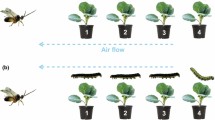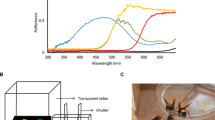Abstract
To cope with environmental variability, animals should gather and use information to reduce uncertainty. In insect parasitoids, associative learning has been widely documented in the context of host foraging. However, despite its potential adaptive value, the insect food searching strategy and cues used to search are poorly understood. In this study, we examined the ability of hymenopteran Venturia canescens females to associate food to a visual cue. To broaden the scope of our results, experiments were performed with both arrhenotokous (sexual) and thelytokous (asexual) individuals. The wasps showed innate attraction for yellow and orange stimuli when presented versus blue stimuli. When trained to associate a food reward with one of the attractive colours (orange), they significantly moved from a distance towards the colour previously associated with food. The choice of the innately preferred colour (yellow) was not modified by associative learning. In the context of food foraging, this study is the first to show associative learning using visual stimuli in a parasitoid and active choice of this colour. This ability gives new insights concerning potential food sources for V. canescens in the field, since flowers are sugar sources, which emit colour signals.



Similar content being viewed by others
References
Amat I (2004) Coexistence de la reproduction sexuée et asexuée chez l’hyménoptère parasitoïde Venturia canescens: Aspects comportementaux et écologiques. Ph.D. dissertation. Université de Lyon 1
Arthur AP (1971) Associative learning by Nemeritis canescens (Hymenoptera: Ichneumonidae). Can Entomol 103:1137–1141
Baker HG, Baker I (1983) A brief historical review of the chemistry of floral nectar. In: Bentley BL, Elias TS (eds) The biology of nectaries. Columbia University Press, New York, pp 126–152
Beling I (1932) Zur Biologie von Nemeritis canescens Grav. (Hymen. Ophion). Z Angew Entomol 19:223–249
Bernstein C, Jervis MA (2008) Food-searching in parasitoids: the dilemma of choosing between “immediate” or future fitness gains. In: Wajnberg E, Bernstein C, van Alphen JJM (eds) Behavioural ecology of insect parasitoids. Blackwell Publishing, Oxford, pp 129–171
Beukeboom LW, Driessen G, Luckerhoff L, Bernstein C, Lapchin L, van Alphen JJM (1999) Distribution and relatedness of sexual and asexual Venturia canescens (Hymenoptera). Proc Sect Exp Appl Entomol Neth Entomol Soc 10:23–28
Briscoe AD, Chittka L (2001) The evolution of colour vision in insects. Annu Rev Entomol 46:471–510
Casas J, Driessen G, Mandon N, Wielaard S, Desouhant E, van Alphen JJM, Lapchin L, Rivero A, Christides JP, Bernstein C (2003) Energy dynamics in a parasitoid foraging in the wild. J Anim Ecol 72:691–697
Castelo MK, Corley JC, Desouhant E (2003) Conspecific avoidance during foraging in Venturia canescens (Hymenoptera: Ichneumonidae): the roles of host presence and conspecific densities. J Insect Behav 16:307–318
Chittka L (1992) The color hexagon—a chromaticity diagram based on photoreceptor excitations as a generalized representation of color opponency. J Comp Physiol A 170:533–543
Chittka L, Shmida A, Troje N, Menzel R (1994) Ultraviolet as a component of flower reflections, and the colour perception of Hymenoptera. Vis Res 34:1489–1508
Crawley MJ (2002) Statistical computing. An introduction to data analysis using S-Plus. Wiley, Chichester
Cruden RW, Hermann SM, Peterson S (1983) Patterns of nectar production and plant-pollinator coevolution. In: Bentley BL, Elias TS (eds) The biology of nectaries. Columbia University Press, New York, pp 80–125
Desouhant E, Driessen G, Amat I, Bernstein C (2005) Host and food searching in a parasitic wasp Venturia canescens: a trade-off between current and future reproduction? Anim Behav 70:145–152
Gilbert FS, Jervis MA (1998) Functional, evolutionary and ecological aspects of feeding-related mouthpart specialization in parasitoid flies. Biol J Linn Soc Lond 63:495–535
Giurfa M, Vorobyev M (1997) The detection and recognition of color stimuli by honeybees: performance and mechanisms. Isr J Plant Sci 45:129–140
Giurfa M, Nuñez JA, Chittka L, Menzel R (1995) Color preferences of flower-naive honeybees. J Comp Physiol A 177:247–259
Gould JL (1993) Ethological and comparative perspectives on honey bee learning. In: Papaj DR, Lewis AC (eds) Insect learning: ecological and evolutionary perspectives. Chapman & Hall, New York, pp 18–50
Heimpel GE, Collier TR (1996) The evolution of host-feeding behavior in insect parasitoids. Biol Rev 71:373–400
Heimpel GE, Rosenheim JA, Kattari D (1997) Adult feeding and lifetime reproductive success in the parasitoid Aphytis melinus. Entomol Exp Appl 83:305–315
Jervis MA (1998) Functional and evolutionary aspects of mouthpart structure in parasitoid wasps. Biol J Linn Soc Lond 62:461–493
Jervis MA, Kidd NAC (1986) Host-feeding strategies in Hymenopteran parasitoids. Biol Rev 61:395–434
Jervis MA, Kidd NAC (1995) Incorporating physiological realism into models of parasitoid feeding behavior. Trends Ecol Evol 10:434–436
Jervis MA, Kidd NAC, Fitton MG, Huddleston T, Dawah HA (1993) Flower-visiting by Hymenopteran parasitoids. J Nat Hist 27:67–105
Jervis MA, Hawkins BA, Kidd NAC (1996) The usefulness of destructive host-feeding parasitoids in classical biological control: theory and observation conflict. Ecol Entomol 21:41–46
Kevan PG (1972) Insect pollination of high Arctic flowers. J Ecol 60:831–847
Kevan PG (1999) Pollinators as bioindicators of the state of the environment: species, activity and diversity. Agric Ecosyst Environ 74:373–393
Kevan PG, Baker HG (1983) Insects as flower visitors and pollinators. Annu Rev Entomol 28:407–453
Kevan PG, Chittka L, Dyer AG (2001) Limits to the salience of ultraviolet: lessons from colour vision in bees and birds. J Exp Biol 204:2571–2580
Lee JC, Heimpel GE (2002) Nectar availability and parasitoid sugar feeding. In: First international symposium on biological control of arthropods. Honolulu
Leius K (1967) Influence of wild flowers on parasitism of tent caterpillar and codlins moth. Can Entomol 99:444–446
Lewis WJ, Takasu K (1990) Use of learned odours by a parasitic wasp in accordance with host and food needs. Nature 348:635–636
Lobdell CE, Yong T-H, Hoffmann MP (2005) Host color preferences and short-range searching behavior of the egg parasitoid Trichogramma ostriniae. Entomol Exp Appl 116:127–134
Lucchetta P (2007) Rôle de l’information dans les stratégies de recherche et d’exploitation des ressources chez l’hyménoptère parasitoïde Venturia canescens. Ph.D. dissertation, Université Lyon 1, Université de Lyon
Lucchetta P, Desouhant E, Wajnberg E, Bernstein C (2007) Small but smart: the interaction between environmental cues and internal state modulates host-patch exploitation in a parasitic wasp. Behav Ecol Sociobiol 61:1409–1418
Lunau K, Maier EJ (1995) Innate color preferences of flower visitors. J Comp Physiol A 177:1–19
Lunau K, Wacht S, Chittka L (1996) Colour choices of naive bumble bees and their implications for colour perception. J Comp Physiol A 178:477–489
Menzel R, Greggers H, Hammer M (1993) Functional organization of appetitive learning and memory in a generalist pollinator, the honey bee. In: Papaj DR, Lewis AC (eds) Insect learning: ecological and evolutionary perspectives. Chapman & Hall, New York, pp 79–125
Neumeyer C (1980) Simultaneous color contrast in the honeybee. J Comp Physiol A 139:165–176
Oliai SE, King BH (2000) Associative learning in response to color in the parasitoid wasp Nasonia vitripennis (Hymenoptera: Pteromalidae). J Insect Behav 13:55–69
Papaj DR (1993) Automatic behavior and the evolution of instinct: lessons from learning in parasitoids. In: Papaj DR, Lewis AC (eds) Insect learning: ecological and evolutionary perspectives. Chapman & Hall, New York, pp 243–272
Papaj DR, Lewis AC (1993) Insect learning. Ecological and evolutionary perspectives. Chapman & Hall, New York
Papaj DR, Vet LEM (1990) Odor learning and foraging success in the parasitoid, Leptopilina heterotoma. J Chem Ecol 16:3137–3150
Peitsch D, Fietz A, Hertel H, Desouza J, Ventura DF, Menzel R (1992) The spectral input systems of hymenopteran insects and their receptor-based color-vision. J Comp Physiol A 170:23–40
Raguso RA (2004) Why are some floral nectar scented? Ecology 85:1486–1494
R Development Core Team (2006) R: a language and environment for statistical computing. R foundation for statistical computing, Vienna. ISSN 3-900052-07-0, URL: http://www.r-project.org
Salt G (1976) The hosts of Nemeritis canescens: a problem in the host specificity of insect parasitoids. Ecol Entomol 1:63–67
Schneider MV, Beukeboom LW, Driesen G, Lapchin L, Bernstein C, van Alphen JJM (2002) Geographical distribution and genetic relatedness of sympatrical thelytokous and arrhenotokous populations of the parasitoid Venturia canescens (Hymenoptera). J Evol Biol 15:191–200
Siekmann G, Tenhumberg B, Keller MA (2001) Feeding and survival in parasitic wasps: sugar concentration and timing matter. Oikos 95:425–430
Sirot E, Bernstein C (1996) Time sharing between host searching and food searching in parasitoids: state-dependant optimal strategies. Behav Ecol 7:189–194
Steidle JLM, van Loon JJA (2003) Dietary specialization and infochemical use in carnivorous arthropods: testing a concept. Entomol Exp Appl 108:133–148
Stephens DW (1993) Learning and behavioral ecology: incomplete information and environmental predictability. In: Papaj DR, Lewis AC (eds) Insect learning: ecological and evolutionary perspectives. Chapman & Hall, New York, pp 195–218
Takasu K, Lewis WJ (1996) The role of learning in adult food location by the larval parasitoid, Microplitis croceipes (Hymenoptera: Braconidae). J Insect Behav 9:265–281
Tenhumberg B, Sieckmann G, Keller MA (2006) Optimal time allocation in parasitic wasps searching for hosts and food. Oikos 113:121–131
Théry M, Casas J (2002) Predator and prey views of spider camouflage. Nature 415:133
Théry M, Debut M, Gomez D, Casas J (2005) Specific color sensitivities of prey and predator explain camouflage in different visual systems. Behav Ecol 16:25–29
Wäckers FL (1994) The effect of food deprivation on the innate visual and olfactory preferences in the parasitoid Cotesia rubecula. J Insect Physiol 40:641–649
Wäckers FL (2000) Do oligosaccharides reduce the suitability of honeydew for predators and parasitoids? A further facet to the function of insect-synthesized honeydew sugars. Oikos 90:197–201
Wäckers FL, Lewis WJ (1994) Olfactory and visual learning and their interactive influence on host site location by the parasitoid, Microplitis croceipes. Biol Control 4:105–112
Wäckers FL, Lewis WJ (1999) A comparison of color-, shape- and pattern-learning by the hymenopteran parasitoid Microplitis croceipes. J Comp Physiol A 184:387–393
Wäckers FL, Steppuhn A (2003) Characterizing nutritional state and food source use of parasitoids collected in fields with high and low nectar availability. IOBC/WPRS Bull 26:209–214
Weevers T (1952) Flower colors and their frequency. Acta Bot Neerl 1:81–92
Winkler K, Wäckers FL, Bukovinszkine-Kiss G, van Lenteren JC (2006) Nectar resources are vital for Diadegma semiclausum fecundity under field conditions. Basic Appl Ecol 7:133–140
Acknowledgements
We are grateful to I. Amat for comments on a first version of the manuscript. Andra Thiel and three anonymous reviewers have commented on an earlier version and provided most helpful advice on how to improve our work. We also thank A. Heizmann and F. Debias for keeping the wasp culture and L. Humblot for his assistance in drawing the figures. This work was supported by a grant from Ecole Doctorale “E2M2” of the University Lyon 1 allocated to P. Lucchetta, two grants allocated to E. Desouhant (BQR 2006 Univ. Lyon 1; ANR “jeunes chercheuses, jeunes chercheurs” (no. JCJC06_138616) and by the CNRS Behavioral Ecology Research Group GDR 2155. Experiments of this study comply with the current laws of the country (France) in which they were performed.
Author information
Authors and Affiliations
Corresponding author
Appendix
Appendix
Colour locus in the colour space simulated for hymenopterans according to the Chittka (1992) model with spectral sensitivity functions of the standard photoreceptors for trichromatic Hymenoptera (adapted from Peitsch et al. 1992)
Rights and permissions
About this article
Cite this article
Lucchetta, P., Bernstein, C., Théry, M. et al. Foraging and associative learning of visual signals in a parasitic wasp. Anim Cogn 11, 525–533 (2008). https://doi.org/10.1007/s10071-008-0144-5
Received:
Revised:
Accepted:
Published:
Issue Date:
DOI: https://doi.org/10.1007/s10071-008-0144-5




